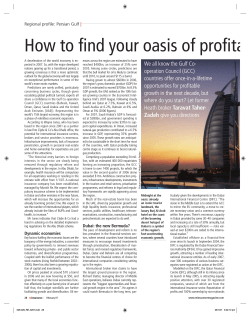
REGIONAL INTEGRATION of THE GULF COOPERATION COUNCIL (GCC)COUNTRIES
REGIONAL INTEGRATION of THE GULF COOPERATION COUNCIL (GCC)COUNTRIES Presented at: Claremont – KIEP Conference on Political Economy of Regional Integration By: Khalfan M. Al Barwani Claremont Graduate University - CGU November 18-19, 2005 1 Objective: To give a general report on the Gulf Cooperation Council – GCC - regional integration and list its achievements and challenges The GCC as an optimum currency area (OCA) The GCC in the regional political and security context Members: Bahrain, Kuwait Oman, Qatar, Saudi Arabia and the United Arab Emirates (the UAE) Combined Population (GRC, 2003): Approx 34 million Combined Real GDP (GRC, 2003): Approx 390 billion Geographical location: Persian Gulf or Arabian Gulf Peninsula Combined share of world crude oil reserves (Bank of Scotland): Approx 50% 2 GCC REGIONAL MAP 3 GCC Regional Profile General Economic Profile Poorly diversified and mostly centralized economies with marginal private sector though changing of late - UAE, Bahrain, and Oman Heavy reliance on hydrocarbon resources for both domestic and external economies. On average hydrocarbon as share of GDP is estimated a little over 40% Trade among GCC member states is less than 10% of total export and less than 5% of the total GDP Governments expenditures fluctuate with world oil prices – May not require sterilization if some of the windfall from higher oil prices is put aside All six currencies are pegged to the US dollar FDI is mostly in the hydrocarbon sector and related industries Fairly open economies relative to the rest of the Middle East Unemployment pressures among nationals are emerging 4 General Political Profile All six member states are absolute and hereditary monarchies with varying but limited political participations All leaders can issue decrees with no institutional constraints Their respective Judiciaries are simply extensions of the Executives Other GCC Features All GCC countries have small populations with exception of Saudi Arabia (25.8 million) Both public and private sectors rely heavily on expatriate workforce (at various degrees) with more pronouncement in the private sector On average 95% of domestic workforce is employed by the public sector Similarities in culture and language 5 GCC Stated Objectives and Rationales for Integration Stated Objectives In 1981 the members ratified a charter that called for the establishment for the cooperation council for the Arab States The overall charter stipulates that the GCC is a political, economic and regional organization and list four main objectives Rationales for the GCC regional integration The question is to what extent these stated objectives are dictated by economic, political, regional security, or global imperatives Various rationales and theories have been advanced and include: Joint security given the instability of the region Collective external threats Economic rationale Geographical proximity Political, institutional, and cultural similarities 6 Collective Security Rationales The onset of Iranian Islamic Revolution of 1979 The invasion of Kuwait by Iraq in 1990 with the subsequent first Gulf War The US invasion of Iraq in 2003 and the concern for instability to spillover to the GCC countries Offshore Islands dispute between Iran and the UAE The massive presence of western military forces in the GCC countries Economic Rationales Endogenous optimum currency area (OCA) argument – increase in trade following the adoption of fixed exchange rate Elimination of transaction costs and risks associated with flexible exchange rates Collective bargaining power on negotiating trade agreements with other regional integrations and countries as a block Allow for easy capital movement and efficient resources allocations 7 • Implemented Steps and Agreed Objectives 1983 1999 2000 Established a free trade zone 2001 2002 Accord reached on a joint custom tariff of 5% 2003 2003 2004 Joint custom tariff of 5% is implemented 2007 Envisages a common market 2010 Projected implementation of a unified currency Agreement on custom union Agreement is concluded to adopt a common peg as a step toward creating a unified currency in 2010 US dollar is selected as intermediate peg to the six currencies* Formal adoption of the US dollar as intermediate peg Agree in “principle” on key convergence criteria: size of budget deficit, inflation rate, interest rates, foreign reserves and ratio of public debt to GDP 8 EMU vs. GCC Macroeconomic Convergence Criteria EMU Criteria GCC Agreed Criteria Average rate of inflation over the previous 12 months Must not exceed by more than Weighted average of the 1.5 percentage points of the six countries plus 2% three best performing member states Deficit Should not exceed 3% of the GDP Should not exceed 3% of the GDP although some flexibility will be allowed to account for wild fluctuations in states revenues Gross public debt Should not exceed 60% of the GDP Should not exceed 60% of the GDP Interest rates Average of the lowest six countries plus 2% Average of the lowest six countries plus 2% 9 High Oil Prices Effects on the GCC Economies Massive Trade Surplus Current Account Surplus Windfall Heavy Gov. Investment Fuel Private Sector Demand Higher Oil Prices Problems Immediate Effects Higher Prices on Goods & Services Higher Inflation Second-Tier Effects Wages Increases in Pub. Sector Increase real income Generate Extra Demand Push Prices higher 10 GCC Monetary Policy Usual Role of Central Banks in Lowering Inflation Through monetary policy Stabilize growth and prices and minimize their volatility Can lead to painful economic adjustments such as unemployment or inflation GCC Monetary Policy Has been essentially targeted at maintaining the stability of exchange rate as a nominal anchor for the economy Given the fairly free mobility of capital, the actual pegging of the national currencies to the U.S. dollar has also required the GCC interest rates to trail closely the movements of U.S. dollar interest rates Consequences for the GCC Countries Limited policy tools to deal with or cap inflation The fall of the US dollar against the Euro (the currency of the GCC’s main trading partner) compounds the problem Some are proposing Flexible exchange rate and independent monetary policy 11 Obstacles and Challenges towards GCC Integration Economic Challenges Low factor mobility within GCC countries Low economic diversification Low intra - GCC trade Mixed macroeconomic convergence Some members economies are getting more diversified than others Political and Institutional Challenges Political will to abdicate national sovereignty on economic policy responses to shocks Harmonization of existing institutions before moving forward with GCC integration Agree on the extent of powers of a supra GCC institution The role, influence, identity and power of the hegemon 12 Intra – GCC Disputes A number of GCC countries such as Bahrain, Kuwait, Oman, and Qatar, and the UAE have signed or are in the process of signing separate trade agreements with the US at the dismay of Saudi Arabia Other disputes that challenge the GCC regional integration have to do with border demarcations among the member states over areas rich in crude oil and natural gas and they include: The UAE and Saudi Arabia Qatar and Saudi Arabia Kuwait and Saudi Arabia Oman and the UAE – Resolved Bahrain and Qatar – Resolved Oman and Saudi Arabia - Resolved 13 Selected Quotes from GCC Regional Papers and Publications “UAE firm on sovereignty over waters of Al Adeed ” (Khaleej Times July 1, 2005) – Area of dispute with Saudi Arabia “Riyadh protests Qatar-UAE bridge over Al Adeed waterway (Al – Jazeera, June 29, 2005) “GCC integration --- more rhetorical than real (GRC Publication, May 27, 2005) “ The Gulf Cooperation Council (GCC) was born to tackle political, security and economic matters----Is it doing what it is supposed to do? No---Qatar is currently exporting gas to Korea, but not to Kuwait awaiting the approval from Saudi Arabia to allow the pipe line to cross through its territory” (Qatari Foreign Minister quoted by GRC Publication, May 27, 2005) “Saudi Crown Prince Abd Allah bin Abd al-Aziz will not attend the forthcoming GCC summit in Bahrain amid growing intra-Gulf differences on free trade” (Al-Jazeera, December 19, 2004) 14 Conclusion On regional integration as a whole some objectives are achievable and others may not be Security agreements and alignment on foreign policies have been some what successful Some steps towards full integration have been implemented and others have not Lack of institutional convergence and the fear of losing sovereignty on economic policies have hindered the progress towards the full integration A number of basic OCA criteria have yet to be met and convergence criteria are yet to be met or implemented Regional disputes hinder the progress towards GCC MU Neither costs nor benefits are expected to be large for the GCC MU 15
© Copyright 2025

















